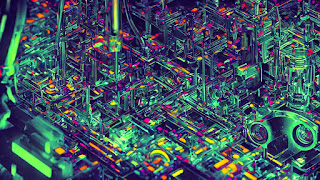First, the image seen above is from a series of protest photos by a man named Chauncey Hare. That's him in his own photo, sitting in his cubicle at the EPA. He thinks big business and their big owners are taking over the world, and he's probably right.
One thing that's pretty certain -- we are not in control, not of the world at large, and not even of ourselves.
Image credit: Chauncey Hare - Self Portrait at EPA - 1980 [Protest Photos]
Chauncey Hare, "Self Portrait at EPA" (1980), from Quitting Your Day Job: Chauncey Hare’s Photographic Work by Robert Slifkin (MACK, 2022), Chauncey Hare Photograph Archive, BANC PIC 2000.012.14:023- 024—ffALB. This photograph was made by Chauncey Hare to protest and warn against the growing domination of working people by multi-national corporations and their elite owners and managers. (© The Regents of the University of California, The Bancroft Library, University of California, Berkeley) https://hyperallergic.com/741181/chauncey-hare-quitting-your-day-job/
Researcher offers new explanation for consciousness
Oct 2022, phys.org
Deepak Chopra's pissed:
"In a nutshell, our theory is that consciousness developed as a memory system that is used by our unconscious brain to help us flexibly and creatively imagine the future and plan accordingly," explained corresponding author Andrew Budson, MD, professor of neurology. "What is completely new about this theory is that it suggests we don't perceive the world, make decisions, or perform actions directly. Instead, we do all these things unconsciously and then—about half a second later—consciously remember doing them."
"Even our thoughts are not generally under our conscious control. This lack of control is why we may have difficulty stopping a stream of thoughts running through our head as we're trying to go to sleep, and also why mindfulness is hard," adds Budson.
via Boston University School of Medicine: Andrew E. Budson et al, Consciousness as a Memory System, Cognitive and Behavioral Neurology (2022). DOI: 10.1097/WNN.0000000000000319
Scientists identify pathway that triggers mice to scratch when they see others do the same
Oct 2022, phys.org
"Contagious itching" is controlled through a visual pathway, that surprisingly, operates independently of the visual cortex.
You can see without a visual cortex. What else do we not-see?
via Washington University School of Medicine in St Louis: Fang Gao et al, A non-canonical retina-ipRGCs-SCN-PVT visual pathway for mediating contagious itch behavior, Cell Reports (2022). DOI: 10.1016/j.celrep.2022.111444.
A handful of universities seem to control flow of ideas, people in academia
Oct 2022, phys.org
Just network science telling us what to do, as usual:
The structure of the American professoriate -- five U.S. universities have trained 1-in-8 tenure-track faculty members serving at the nation's institutions of higher learning.
(University of California, Berkeley; Harvard University; University of Michigan; Stanford University; and University of Wisconsin-Madison)
via University of Colorado at Boulder: Daniel Larremore, Quantifying hierarchy and dynamics in US faculty members hiring and retention, Nature (2022). DOI: 10.1038/s41586-022-05222-x
Post Script:
Scientists obtain effects through virtual reality comparable to those of psychedelic drugs
Sep 2022, phys.org
They design virtual reality intersubjective group spaces where participants experience together the collective emergence, fluctuation and dissipation of their own bodies, and which produce responses similar to those triggered by psychoactive drugs.
Something about this says
Robert Heinlein to me. A social science fiction perhaps.
via Intangible Realities Laboratory at the Citius Intelligent Technologies Research Centre, Santiago de Compostela, Spain; and ArtSci International Foundation in Bristol: David R. Glowacki et al, Group VR experiences can produce ego attenuation and connectedness comparable to psychedelics, Scientific Reports (2022). DOI: 10.1038/s41598-022-12637-z







